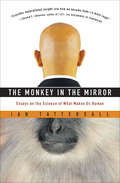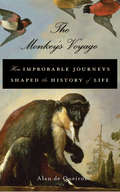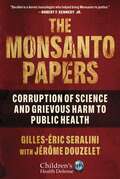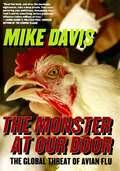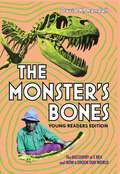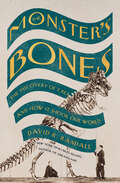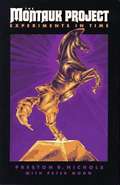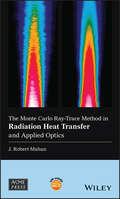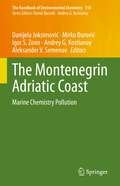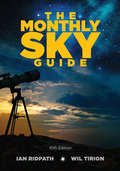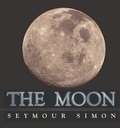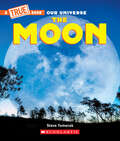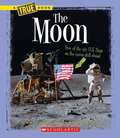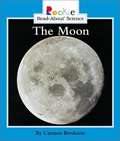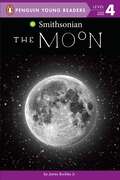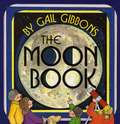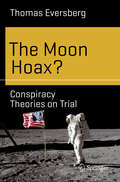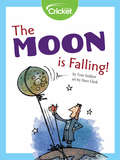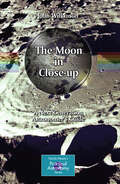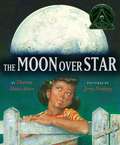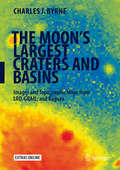- Table View
- List View
The Monkey in the Mirror: Essays on the Science of What Makes Us Human
by Ian TattersallAn “absorbing” look at how our species evolved, from the curator of human evolution at the American Museum of Natural History (Kirkus Reviews).What makes us so different from those other animals? How did we get this way? How do we know? And what exactly are we? These questions are what make human evolution a subject of general fascination. Ian Tattersall, one of those rare scientists who is also a graceful writer, addresses them in this delightful book.Tattersall leads the reader around the world and into the far reaches of the past, showing what the science of human evolution is up against—from the sparsity of evidence to the pressures of religious fundamentalism. Looking with dispassion and humor at our origins, Tattersall offers a wholly new definition of what it is to be human.“Unparalleled insight.” —Donald C. Johanson, author of Lucy: The Beginnings of Humankind
The Monkey's Voyage: How Improbable Journeys Shaped the History of Life
by Alan De QueirozHow did species wind up where they are today? Scientists have long conjectured that plants and animals dispersed throughout the world by drifting on large landmasses as they broke up, but in The Monkey's Voyage, biologist Alan de Queiroz offers a radical new theory that displaces this passive view. He describes how species as diverse as monkeys, baobab trees, and burrowing lizards made incredible long-distance ocean crossings: pregnant animals and wind-blown plants rode rafts and icebergs and even stowed away on the legs of sea-going birds to create the map of life we see today. In the tradition of John McPhee's Basin and Range and David Quammen's The Song of the Dodo, The Monkey's Voyage is a beautifully told narrative of a profound investigation into the importance of contingency in history and the nature of scientific discovery.
The Monkeys of Stormy Mountain
by Jean-Baptiste Leca Michael A. Huffman Paul L. VaseyThe Arashiyama group of Japanese macaques holds a distinguished place in primatology as one of the longest continuously studied non-human primate populations in the world. The resulting long-term data provide a unique resource for researchers, allowing them to move beyond cross-sectional studies to tackle larger issues involving individual, matrilineal and group histories. This book presents an overview of the scope and magnitude of research topics and management efforts that have been conducted on this population for several decades, covering not only the original troop living around Kyoto, Japan, but also the two subgroups that were translocated to Texas, USA and Montreal, Canada. The chapters encompass topics including life history, sexual, social and cultural behaviour and ecology, giving an insight into the range of current primatological research. The contributors underscore the historic value of the Arashiyama macaques and showcase new and significant research findings that highlight their continuing importance to primatology.
The Monsanto Papers: Corruption of Science and Grievous Harm to Public Health (Children’s Health Defense)
by Gilles-Éric Seralini Jérôme DouzeletA David and Goliath battle for truth A specialist in GM foods and pesticides, the biologist Gilles-Éric Seralini has studied their toxicity and effects on people's health for many years. In September 2012, for the first time in a major scientific journal (Food and Chemical Toxicology), he published a study showing the effect on the liver and kidneys of two of Monsanto's flagship products: Roundup weedkiller and the GM foods created to absorb it. Images from the study of tumor-ridden rats fed with GM foods and Roundup went viral. The study was a PR disaster for Monsanto. The multinational soon bounced back and did everything in its power to cover up the study—leaning on the publishers to retract the findings. Monsanto began a series of smear campaigns to discredit Seralini and fellow researchers and intimidate their supporters, while pumping out their own collection of fake research findings and testimonies. These practices were met with huge suspicion, but there was no concrete evidence until, in 2017, Monsanto was ordered to publish tens of thousands of confidential documents in a class-action lawsuit presented by thousands of individuals afflicted with serious illnesses from their use of Roundup. The "Monsanto Papers" that were produced subsequently proved the company&’s cynical attempts at a cover-up as well as its fraudulent practices. Gilles-Éric Seralini and Jérôme Douzelet delved into the documents and discovered how, in the pursuit of its own short term economic interests, Monsanto used sophisticated methods of deceit to bypass legislation devised to protect millions of people. Seralini and Douzelet discovered how Monsanto managed to provide phony assessments to conceal the poisons its products contain, thus deceiving the public authorities and the scientific and medical communities.
The Monster at Our Door: The Global Threat of Avian Flu
by Mike DavisIn this urgent and extraordinarily frightening book, Mike Davis reconstructs the scientific and political history of a viral apocalypse in the making, exposing the central roles of agribusiness and the fast-food industries, abetted by corrupt governments, in creating the ecological conditions for the emergence of this new plague. He also details the scandalous failure of the Bush administration, obsessed with hypothetical "bio-terrorism," to safeguard Americans from the greatest biological threat since HIV/AIDS.
The Monster's Bones (Young Readers Edition) (Young Readers Edition) (Young Readers Edition) (Young Readers Edition): The Discovery of T. Rex and How It Shook Our World: The Discovery Of T. Rex And How It Shook Our World
by David K. RandallThe thrilling tale of America’s early paleontologists and the discovery of the first T. Rex fossil, now adapted for young readers. From the dust of the Gilded Age Bone Wars, two vastly different men emerge to fill the empty halls of New York’s struggling American Museum of Natural History: socialite Henry Fairfield Osborn and intrepid fossil hunter Barnum Brown. When Brown unearths the first Tyrannosaurus Rex fossils, Osborn sees a path to save his museum from irrelevancy. As the public turns out in droves to cower before this bone-chilling giant of the past and wonder at the mysteries of its disappearance, Brown and Osborn turn dinosaurs into a beloved part of culture. In this vivid and engaging young readers adaptation, New York Times best-selling author David K. Randall journeys from prehistory to present day, from remote Patagonia to the unforgiving Badlands of the American West to the penthouses of Manhattan. The Monster’s Bones reveals how a monster of a bygone era ignited a new understanding of our planet and our place within it.
The Monster's Bones: The Discovery of T. Rex and How It Shook Our World
by David K. RandallA gripping narrative of a fearless paleontologist, the founding of America’s most loved museums, and the race to find the largest dinosaurs on record. In the dust of the Gilded Age Bone Wars, two vastly different men emerge with a mission to fill the empty halls of New York’s struggling American Museum of Natural History: Henry Fairfield Osborn, a privileged socialite whose reputation rests on the museum’s success, and intrepid Kansas-born fossil hunter Barnum Brown. When Brown unearths the first Tyrannosaurus Rex fossils in the Montana wilderness, forever changing the world of paleontology, Osborn sees a path to save his museum from irrelevancy. With four-foot-long jaws capable of crushing the bones of its prey and hips that powered the animal to run at speeds of 25 miles per hour, the T. Rex suggests a prehistoric ecosystem more complex than anyone imagined. As the public turns out in droves to cower before this bone-chilling giant of the past and wonder at the mysteries of its disappearance, Brown and Osborn together turn dinosaurs from a biological oddity into a beloved part of culture. Vivid and engaging, The Monster’s Bones journeys from prehistory to present day, from remote Patagonia to the unforgiving badlands of the American West to the penthouses of Manhattan. With a wide-ranging cast of robber barons, eugenicists, and opportunistic cowboys, New York Times best-selling author David K. Randall reveals how a monster of a bygone era ignited a new understanding of our planet and our place within it.
The Montauk Project: Experiments In Time
by Preston B. NicholsDiscover the truth about time. This book chronicles the most amazing and secretive research project in recorded history. We all know something is out there, we're just not sure exactly what. This book begins to provide some solid clues.
The Monte Carlo Ray-Trace Method in Radiation Heat Transfer and Applied Optics (Wiley-ASME Press Series)
by J. Robert MahanA groundbreaking guide dedicated exclusively to the MCRT method in radiation heat transfer and applied optics The Monte Carlo Ray-Trace Method in Radiation Heat Transfer and Applied Optics offers the most modern and up-to-date approach to radiation heat transfer modelling and performance evaluation of optical instruments. The Monte Carlo ray-trace (MCRT) method is based on the statistically predictable behavior of entities, called rays, which describe the paths followed by energy bundles as they are emitted, reflected, scattered, refracted, diffracted and ultimately absorbed. The author – a noted expert on the subject – covers a wide variety of topics including the mathematics and statistics of ray tracing, the physics of thermal radiation, basic principles of geometrical and physical optics, radiant heat exchange among surfaces and within participating media, and the statistical evaluation of uncertainty of results obtained using the method. The book is a guide to help formulate and solve models that accurately describe the distribution of radiant energy in thermal and optical systems of practical engineering interest. This important guide: Combines radiation heat transfer and applied optics into a single discipline Covers the MCRT method, which has emerged as the dominant tool for radiation heat transfer modelling Helps readers to formulate and solve models that describe the distribution of radiant energy Features pages of color images and a wealth of line drawings Written for faculty and graduate students in mechanical and aerospace engineering and applied optics professionals, The Monte Carlo Ray-Trace Method in Radiation Heat Transfer and Applied Optics is the first book dedicated exclusively to the MCRT method.
The Montenegrin Adriatic Coast: Marine Chemistry Pollution (The Handbook of Environmental Chemistry #110)
by Andrey G. Kostianoy Igor S. Zonn Aleksander V. Semenov Mirko Đurović Danijela JoksimovićThis is the second of two volumes that together provide an integrated picture of the Montenegrin Adriatic coast, presenting the natural components of the system as well as the chemical composition and chemical processes in the extended area. This book covers all aspects of marine chemistry such as the hydrographic and oceanographic characteristics of seawater, the toxicity of heavy metals in the marine environment, the quality of marinas and maritime areas, and the legal regime for protecting the marine environment from pollution. Given the breadth and depth of its coverage, the book offers an invaluable source of information for researchers, students and environmental managers alike.
The Monthly Sky Guide
by Ian RidpathThe ninth edition of Ian Ridpath and Wil Tirion's famous guide to the night sky is updated with planet positions and forthcoming eclipses to the end of the year 2017. It contains twelve chapters describing the main sights visible in each month of the year, providing an easy-to-use companion for anyone wanting to identify prominent stars, constellations, star clusters, nebulae and galaxies; to watch out for meteor showers ('shooting stars'); or to follow the movements of the four brightest planets, Venus, Mars, Jupiter and Saturn. Most of the sights described are visible to the naked eye and all are within reach of binoculars or a small telescope. This revised and updated edition includes sections on observing the Moon and the planets, with a comprehensive Moon map. The Monthly Sky Guide offers a clear and simple introduction to the skies of the northern hemisphere for beginners of all ages.
The Monthly Sky Guide, 10th Edition
by Ian Ridpath"Ian Ridpath and Wil Tirion — two consummate professionals in the field — have teamed up to produce an exemplary text with first-rate illustrations to inspire the beginning sky-gazer. I heartily recommend this text." — Neil English, Astronomy Now magazineA user-friendly companion for stargazers of all ages, this classic beginner's guide describes all the main sights of the night sky. The newly updated book contains a chapter for each month, describing prominent stars, constellations, star clusters, nebulae, and galaxies. Readers will discover when to watch meteor showers, when eclipses will occur, and how to follow the movements of the four brightest planets (Venus, Mars, Jupiter, and Saturn).Most of the sights are visible to the naked eye, and all can be seen with binoculars or a small telescope. Sections on observing the Moon and the planets include 50 easy-to-use maps that introduce the skies of the Northern Hemisphere and a comprehensive guide to observing the Moon. "The star maps are first quality … I find them to be a pleasure to look at and use. If you have a young person or friend you would like to share your love of astronomy with, get them a pair of binoculars and this book and you'll have a stargazing friend for life." — Mike Simonsen, Slacker Astronomy
The Moon
by Seymour SimonFrom Apollo 11's first landing to the mystery of moonquakes and the genesis of craters, this stunning introduction to our nearest neighbor in space describes the moon and its all-important relationship to Earth. Mesmerizing full-color photography and an informative text perfect this exciting and educational journey in space.
The Moon (A True Book (Relaunch))
by Steve TomecekDid you know the moon is considered a natural satellite? Or that its gravity affects ocean tides on Earth? This book explores the closest celestial body to Earth and the ways in which the moon and Earth affect each other.Chapters introduce topics including the moon's origin, its makeup and phases, the first people to walk on its surface, and the moon's role in both lunar and solar eclipses.Planets and stars, moons and galaxies! The universe is a vast and mysterious place with much to explore. And there's no better way to make amazing discoveries about space than with this reimagined series. With the latest NASA imagery, the classic structure and features of A True Book, and lively text, the titles in Our Universe bring the awe of the cosmos directly to readers. Students will come away with a wealth of knowledge about the incredible celestial bodies in our universe.This series covers Next Generation Science Standards core ideas including "The Universe and its stars" and "Earth and the solar system."
The Moon (New True Books: Space)
by Christine Taylor-ButlerHuman beings first set foot on the Moon on July 20, 1969, marking one of the most important events in the history of space exploration. <P><P>A True Book: Space series dives into the many components that make each planet distinctive and exceptional, as well as explore many of the other components that make up Space. This series includes an age appropriate (grades 3-5) introduction to curriculum-relevant subjects and a robust resource section that encourages independent study. <P><P>Since the first moon landing, scientists have continued to learn more about Earth's sole natural satellite. Readers will learn what it is like to walk on the surface of the Moon and what role the satellite plays in the solar system. They will also find out how scientists first began studying the Moon and how they are continuing their exploration today. Lexile Measure: 820
The Moon (Rookie Read-About Science)
by Carmen BredesonThis Rookie Read-About® Science book introduces young readers to the Moon. Colorful photos and simple text encourage children to read on their own as they learn how the Moon moves in space, how its craters were formed, why it seems to shine, and how humans were able to walk on its surface. Other books in this series are available in this library.
The Moon (Smithsonian)
by James BuckleyCheck out the moon—in all its phases—in this new Level 4 Penguin-Smithsonian nonfiction reader.There are myths about it. Men have landed on it. Just about everybody has gazed at it in wonder. But what is the moon? Where did it come from? What&’s it made of? Find out in this lively reader about the celestial body that&’s so familiar and yet so mysterious.
The Moon Book
by Gail GibbonsIdentifies the moon as our only natural satellite, describes its movement and phases, and discusses how we have observed and explored it over the years.
The Moon Hoax?: Conspiracy Theories on Trial (Science and Fiction)
by Thomas EversbergThis book is about the American moon-landings – and about the doubts expressed ever since concerning the reality of these landings. Were the images of men on the moon really just a huge and cleverly executed hoax? Eversberg explains the best-known claims and conspiracy theories, and analyzes the evidence with the help of detailed full-colour images, as well as numerous film documents that can be accessed directly from the book. He addresses both the persistent older claims and more recently devised doubts. The book will inform and entertain a wide range of readers interested in space exploration and tells a gripping story covering physics, politics and history.
The Moon Is Falling!
by Tom SeddonIsaac Newton did not discover gravity; people had noticed it before! But he did figure out the rules for how it works.
The Moon Seems to Change
by Barbara Emberley Ed Emberley Franklyn M. BranleyBecause the moon revolves around Earth, it seems to grow and shrink. Children can read about the phenomena of the moon's phases and with an experiment using an orange, a pencil, and a flashlight, they can see why the moon looks different at different times of the month. 'A welcome addition to science collections for young children. ' -SLJ.
The Moon Seems to Change (Let's-Read-and-Find-Out Science 2)
by Dr. Franklyn M. BranleyRead and find out about the phases of the moon in this colorfully illustrated nonfiction picture book.This clear and appealing science book for early elementary age kids, both at home and in the classroom, introduces basic information about the moon.Have you noticed that the moon sometimes seems to grow and shrink? Does it look like a big round ball? Or is it just a sliver of light in the sky? The moon seems to change. But it doesn't really. The moon revolves around the Earth. It takes about four weeks to make the journey, and as it travels around we can only see certain parts of it. Try the simple experiment described inside using an orange, a pencil, and a flashlight, and you'll understand why the moon seems to change.This is a Level 2 Let's-Read-and-Find-Out, which means the book explores more challenging concepts for children in the primary grades. The 100+ titles in this leading nonfiction series are:hands-on and visualacclaimed and trustedgreat for classroomsTop 10 reasons to love LRFOs:Entertain and educate at the same timeHave appealing, child-centered topicsDevelopmentally appropriate for emerging readersFocused; answering questions instead of using survey approachEmploy engaging picture book quality illustrationsUse simple charts and graphics to improve visual literacy skillsFeature hands-on activities to engage young scientistsMeet national science education standardsWritten/illustrated by award-winning authors/illustrators & vetted by an expert in the fieldOver 130 titles in print, meeting a wide range of kids' scientific interestsBooks in this series support the Common Core Learning Standards, Next Generation Science Standards, and the Science, Technology, Engineering, and Math (STEM) standards. Let's-Read-and-Find-Out is the winner of the American Association for the Advancement of Science/Subaru Science Books & Films Prize for Outstanding Science Series.
The Moon in Close-up
by John WilkinsonInformation collected by recent space probes sent to explore the Moon by the USA, the European Space Agency, Japan, China and India has changed our knowledge and understanding of the Moon, particularly its geology, since the Apollo missions. This book presents those findings in a way that will be welcomed by amateur astronomers, students, educators and anyone interested in the Moon. Enhanced by many colour photos, it combines newly acquired scientific understanding with detailed descriptions and labelled photographic maps of the lunar surface. Guided by observation methods explained in the book and 17 Study Areas presented and carefully explained in the last chapter, amateur astronomers can observe these features from Earth using telescopes and binoculars. Readers who consult the photographic maps will gain a better understanding about the Moon's topography and geology. The book is rounded out by a helpful glossary.
The Moon over Star
by Dianna Hutts AstonOn her family's farm in the town of Star, eight-year-old Mae eagerly follows the progress of the 1969 Apollo 11 flight and moon landing and dreams that she might one day be an astronaut, too.
The Moon's Largest Craters and Basins
by Charles J. ByrneThis most recent book from lunar expert Charles J. Byrne combines the latest comprehensive imagery, topography and gravity data from all three recent Moon missions, Kaguya, Lunar Reconnaissance Orbiter and GRAIL. These major polar-orbit surveys are presented here in compact form for the convenience of amateur and practical astronomers concerned with the Moon. Chosen from the Near and Far Side's large craters and basins over 200 km in diameter, each of the 71 highlighted features is depicted with a two-page presentation of the data that includes false color topographic maps next to the mission images. Additionally, the features are presented in the estimated chronological sequence of their creation, based on a consideration of stratigraphy (overlapping layers from neighboring features) and the relative degradation of surface features. Using this sequence as a way to convey the relative ages of lunar features, the author presents various theories concerning the Moon's impact and thermal history e. g. the available evidence allows for constraints to be placed on the duration of the Late Heavy Bombardment period. The relationships between impact dynamics and variations in the gravity field of the Moon are also discussed. The new mission data makes possible this renewed conjecture about the history and evolution of the Moon, which is presented here with much worthwhile information for amateurs and professionals alike.
